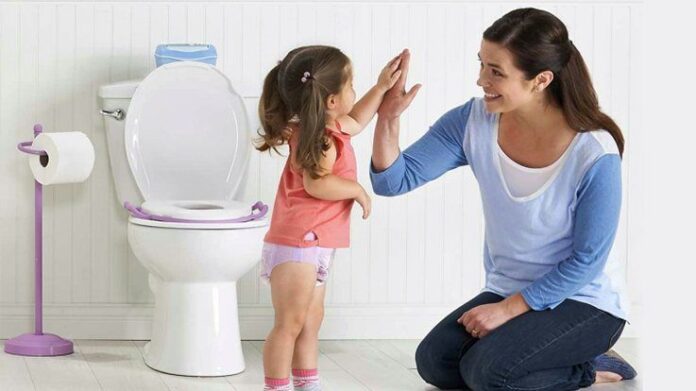Most parents are clueless about when “potty” or toilet training should be imparted to their kids. A child should be emotionally and physically ready to learn basics of toilet training as any resistance from the child can make the process frustrating. Most children aged between twenty-two to thirty months are ready to learn while some take longer or can learn earlier. Generally, girls pick the habit quickly when compared to boys.
You need to assess your child’s readiness to learn by reading signals such as:
- A child’s understanding of basic instructions and toilet lingo.
- Ability to control bowel and bladder muscles.
- Keeping a diaper dry for at least two hours.
- Basic motor skills which will be needed for toilet visits (climbing, balancing and sitting).
- Showing interest in going to the toilet by himself or herself.
- Ability to remove and wear clothing- underpants.
Toilet training your child can take you three to four months, although some children learn fast while others take more time. If your child refuses to go to the toilet, do not force him/her to do otherwise as emotional preparedness is important.
Child will need help while washing and wiping
Your child will require help and supervision in washing and wiping after completing his bowel movements. Understand that a child will need your help and supervision for the entire process as sometimes learning the basics of toilet training can be disrupted due to stress or other factors. A child who is not getting enough attention and support will seem to regress in the development process of toilet training. Consult your doctor as a preventive measure to rule out any health issues your child may be suffering from.
Use the right equipments for your child
While potty training, it is important you use the right equipments for your child. Commonly available equipments are the child-sized potty chair with a bowl in the bottom which can be emptied into the toilet and the other is a child-sized seat which attaches in your regular toilet seat. Children feel scared of falling into the toilet for which a toilet seat can be the solution. Use a stepping stool for your child in order for him/her to climb up onto the seat.
Tips while potty training your child
- Make it a habit for your child to sit on the potty seat when he/she is likely to have his bowel movements. The child will learn to associate toilet activities and the potty seat together. Do not force anything on the child, if he does not want to sit on the seat, you might as well give him/her some break before continuing your training after a few days. The child can start sitting on the toilet seat while being fully clothed and later when it is comfortable for the child, he/she can go bare bottomed.
- Show and tell your child how to use a toilet while explaining him what is happening. A child learns by imitating others around him. From “doing” the activity to hygiene and dressing up, all these need to be conveyed by demonstration.
- Praise your child while he/she is practicing or striving to learn toilet training basics. It will help boost his /her self esteem and motivate the child to learn better.
- Do not punish your child while they are just learning about toilet training. It takes time and patience to teach your child about something which he/she has no idea about. Even while potty training, if your child soils or wets their diaper or bed, remember not to scold them instead offer your support by reassuring them that it was an accident and they will not do it again.


